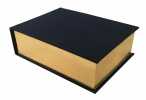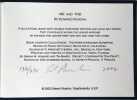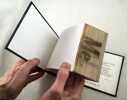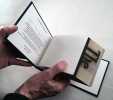RUSCHA EDWARD (né en 1937)
Me and The
2002 Tampa, FL: Graphicstudio, U.S.F., 2002, 133x182x56mm, 576 pages non paginées, tranches dorées, relié sous couverture toilé bleu nuit.Signé et numéroté au colophon 136/230 +21 AP. (104213)
Reference : 104213
Un "Livre sculptural" signé par Ruscha, les mots "Me" et "The" imprimés sur la gouttière du bloc de texte qui apparaissent lorsque l'on courbe les feuilles d'abord dans un sens puis dans l'autre. Une feuille d'information de l'éditeur et jointe. État neuf.
Bookseller's contact details
Librairie Chloé et Denis Ozanne Déesse sarl
M. Denis Ozanne
21 rue Monge
75005 Paris
France
+33 1 48 01 02 37
Payment mode



Sale conditions
Conforme aux usages de la librairie ancienne et moderne, tous les ouvrages présentés sont complets et en bon état, sauf indication contraire. L'exécution des commandes téléphonées est garantie mais sans règle absolue, la disponibilité des livres n'étant pas toujours vérifiable lors de l'appel. Les frais de port sont à la charge du destinataire. Les livres sont payables à la commande. Nous acceptons les règlements par chèque bancaire ou postal, mandat postal ou international, carte bancaire, Visa, Eurocard, MasterCard et virements bancaires dans certaines conditions.
5 book(s) with the same title
Album Photo des Funérailles de S.M. le Roi Edouard VII le Pacifique 20 Mai 1910 [Photo Album : Funeral of H.M. King Edward VII the Pacific May 20, 1910 ]
Album photographique pleine toile format 27 x 28 cm, drapeaux peints en plat, un bouton d'uniforme rapporté au premier plat, 37 photos format carré 21,5 x 21,5 cm : St James's Street 7 heures 1/2 du matin : La musique des Horse Guards - Les Hussards ; Les "6th Rifles" ; La Musique des Horse Guards ; Les Horse Gards le Drummer en tête ; L'Infanterie. L'automobile qui verse le sable sur le parcours ; Le défilé a commencé, les soldats des régiments d'Infanterie portent le canon du fusil baissé en signe de deuil. La foule compacte et respectueuse. Des draperies violettes ou noires à toutes les fenêtres ; Les Scott Guards ; Les Gordon's Highlanders ; L'Artillerie ; Les Hussards ; Les Life Guards ; Des Princes Indiens et des représentants des Colonies ; Lord Fisher of Kilverstone saluant le drapeau suivi des Amiraux ; Les "Blue Jackets" ; Le Duc de Norfolk saluant le drapeau. Etant Earl Marshall de la Cour par droit héréditaire, ce fut lui qui fut chargé d'organiser toutes les solennités depuis la mort du Roi et le cortège d'aujourd'hui ; Les généraux : Sir Charles Douglas. Lord Kitchener, Lord Roberts, Sir Evelyn Wood, les 3 FieldMarshall anglais ; Les représentants allemands des régiments dont le Roi était Colonel ; Les attachés militaires étrangers ; Les représentants autrichiens des régiments dont le Roi était Colonel ; "The Gun carriage" sur laquelle est drapée "The Union Jack" et l'Etendard Royal. Les couronnes royales sont posées sur des coussins ; Le chien du Roi "Caesar" conduit par un Ecossais ; Le cheval du Roi avec les bottes mises à l'envers ; Les Souverains et Princes étrangers suivent : l'Empereur d'Allemagne. Le Roi George V. Le Duc de Conaught. Le porte étendard royal ; Le trompette royal ; Grand-Duc de Hesse, Roi du Danemark ; Les Princes du Sang : Le Duc d'Aoste ; La voiture de la Reine Mary ; La voiture des Princes ; Les "Life Guards" qui ferment le cortège ; Retour à la caserne des troupes ("Life Guards", Artilleurs, Hussards, Musique de l'Infanterie, Trumpetter [ English translation : St James's Street 7:30 a.m.: The Band of the Horse Guards - The Hussars; The "6th Rifles"; The Band of the Horse Guards; The Horse Guards the Drummer in the lead; Infantry. The car that pours the sand on the course; The procession has begun, the soldiers of the infantry regiments carry the gun barrel lowered as a sign of mourning. The compact and respectful crowd. Purple or black draperies on all windows; The Scott Guards; The Gordon's Highlanders; Artillery; The Hussars; The Life Guards; Indian Princes and Colonial Representatives; Lord Fisher of Kilverstone saluting the flag followed by the Admirals; The "Blue Jackets"; The Duke of Norfolk saluting the flag. Being Earl Marshall of the Court by hereditary right, it was he who was responsible for organizing all the solemnities since the death of the King and the procession of today; Generals: Sir Charles Douglas. Lord Kitchener, Lord Roberts, Sir Evelyn Wood, the 3 English FieldMarshalls; The German representatives of the regiments of which the King was Colonel; Foreign military attaches; Representatives from regiments of which the King was Colonel; "The Gun chariot" on which is draped "The Union Jack" and the Royal Standard. The royal crowns are placed on cushions; The King's dog "Caesar" led by a Scotsman; The King's horse with the boots turned upside down; Foreign Sovereigns and Princes follow: the Emperor of Germany. King George V. The Duke of Conaught. The royal standard bearer; The Royal Trumpet; Grand Duke of Hesse, King of Denmark; The Princes of the Blood: The Duke of Aosta; Queen Mary's Carriage; The Princes' car; The "Life Guards" who ferment the procession; Return to Troop Barracks ("Life Guards", Gunners, Hussars, Infantry Band, Trumpetter ]
Bel album photographique, provenant de la bibliothèque d'Ernesta Stern (1854-1926) alias "Maria Star", écrivain fameuse pour son salon du Faubourg Saint-Honoré où elle accueillit notamment Marinetti ou Marcel Proust. Née Maria Ernesta Hierschel de Minerbi, elle épousa le banquier Louis Stern. Beautiful photographic album, from the library of Ernesta Stern (1854-1926), writer famous for her salon in Faubourg Saint-Honoré where she notably welcomed Marinetti or Marcel Proust. Born Maria Ernesta Hierschel de Minerbi, she married the banker Louis Stern.
Album Souvenir des Funérailles du Roi Edouard VII. Recueil de Journaux et Documents - Souvenir Album of the Funeral of King Edward VII. Collection of Newspapers and Documents : The Daily Mirror. N°2048 20 May 1910 : The Kaiser arrives - Evening Standard and St James Gazette n°26794 May 19, 1910 : Kaiser's arrival ; Official Programme of the Funeral Procession of his late Majesty King Edward VII, Friday May 20th 1910 ; ; The Sketch Double number May 11 1910. The Death of King Edward VII ; The Graphic Specla Number 2110A May 11, 1910, The Life of King Edward VII ; The Graphic. An illustrated weekly newspaper. Saturday May 14, 1910. King George V driving to St James's Palace to hold his first council ; The Sphere, n° 538, May 14, 1910 : Edward VII 1841-1910 ; The Illustrated London News double number. May 14, 1910, n° 3708 ; The Graphic. An illustrated weekly newspaper. n° 2112 Saturday May 21, 1910 : King Adward last sleep at Buckingham Palace ; Black & Whit May 21st 1910. A Nation in Mourning. In Memoriam ; The Graphic 2112A May 24 1910. Funeral of Edward VII ; The Sphere. n° 540 May 28, 1910 : Funeral Number. Edward the Peacemaker
1 vol. in folio reliure pleine toile grise, format 42 x 33 cm, blason collé au premier plat avec devise "Dieu et mon droit", Album Souvenir des Funérailles du Roi Edouard VII. Recueil de Journaux et Documents - Souvenir Album of the Funeral of King Edward VII. Collection of Newspapers and Documents : The Daily Mirror. N°2048 20 May 1910, 16 pp. : The Kaiser arrives - Evening Standard and St James Gazette n°26794 May 19, 1910 : Kaiser's arrival, 20 pp. ; Official Programme of the Funeral Procession of his late Majesty King Edward VII, Friday May 20th 1910, 4 ff. ; ; The Sketch Double number May 11 1910. The Death of King Edward VII ; The Graphic Specla Number 2110A May 11, 1910, The Life of King Edward VII ; The Graphic. An illustrated weekly newspaper. Saturday May 14, 1910. King George V driving to St James's Palce to hold his first council ; The Sphere, n° 538, May 14, 1910 : Edward VII 1841-1910 ; The Illustrated London News double number. May 14, 1910, n° 3708 ; The Graphic. An illustrated weekly newspaper. n° 2112 Saturday May 21, 1910 : King Adward last sleep at Buckingham Palace ; Black & Whit May 21st 1910. A Nation in Mourning. In Memoriam ; The Graphic 2112A May 24 1910. Funeral of Edward VII ; The Sphere. n° 540 May 28, 1910 : Funeral Number. Edward the Peacemaker
Bel album souvenir, recueillant de nombreux journaux et magazines de l'époque, et provenant de la bibliothèque d'Ernesta Stern (1854-1926) alias "Maria Star", écrivain fameuse pour son salon du Faubourg Saint-Honoré où elle accueillit notamment Marinetti ou Marcel Proust. Née Maria Ernesta Hierschel de Minerbi, elle épousa le banquier Louis Stern. Beautiful souvenir album, collecting many newspapers and magazines of the time, and coming from the library of Ernesta Stern (1854-1926) alias "Maria Star", famous writer for her salon in Faubourg Saint-Honoré where she notably welcomed Marinetti or Marcel Proust. Born Maria Ernesta Hierschel de Minerbi, she married the banker Louis Stern.
Jubilé de la Reine Victoria. 22 juin 1897. Album unique composé de documents collectés par Ernesta Stern dont : Plan de l'itinéraire de la procession ; 6 photographies par Downey, photographe de la Reine ; Portrait de la reine par Nicholson (gravure sur bois en couleurs) ; 3 invitations diverses ; Programme du Royal Opera Covent Garden du 23 juin 1897, sur soie à galons d'argent ("To commemorate the sixtieth anniversary of Her Majest's Accession to the Throne") ; 5 ephemera dont invitation de Lord Chamberlain à l'Afternoon Party du 28 juin 1897 à Buckingham Palace ("The Lord Chamberlain is commanded by The Queen to invite Monsieur & Madame Stern & Mademoiselle Stern to an afternoon Party on Monday, the 28th of June, from 5 to 7 o'Clock. Buckingham Palace") , etc... - Jubilee of Queen Victoria. June 22, 1897. Unique album composed of documents collected by Ernesta Stern including: Map of the route of the procession; 6 photographs by Downey, photographer to the Queen; Portrait of the Queen by Nicholson (colour woodcut); 3 various invitations; Program of the Royal Opera Covent Garden of June 23, 1897, on silk with silver braid ("To commemorate the sixtieth anniversary of Her Majest's Accession to the Throne"); 5 ephemera including Lord Chamberlain's invitation to the Afternoon Party of 28 June 1897 at Buckingham Palace ("The Lord Chamberlain is commanded by The Queen to invite Monsieur & Madame Stern & Mademoiselle Stern to an afternoon Party on Monday, the 28th of June, from 5 to 7 o'Clock. Buckingham Palace"), etc.
Album in-folio oblong (41 x 63 cm) pleine toile grise d'époque, armes d'Angleterre peintes sur le premier plat, médaille incrustée en bas du premier plat ("Victoria Regina et Imperatrix" à l'avers, "In Commemoration Victoria 1837-1897" au revers), Jubilé de la Reine Victoria. 22 juin 1897. Album unique composé de documents collectés par Ernesta Stern dont : Plan de l'itinéraire de la procession ; 6 photographies par Downey, photographe de la Reine ; Portrait de la reine par Nicholson (gravure sur bois en couleurs) ; 3 invitations diverses ; Programme du Royal Opera Covent Garden du 23 juin 1897, sur soie à galons d'argent ("To commemorate the sixtieth anniversary of Her Majest's Accession to the Throne") ; 5 ephemera dont invitation de Lord Chamberlain à l'Afternoon Party du 28 juin 1897 à Buckingham Palace ("The Lord Chamberlain is commanded bu The Queen to invite Monsieur & Madame Stern & Mademoiselle Stern to an afternoon Party on Monday, the 28th of June, from 5 to 7 o'Clock. Buckingham Palace") - Jubilee of Queen Victoria. June 22, 1897. Unique album composed of documents collected by Ernesta Stern including: Map of the route of the procession; 6 photographs by Downey, photographer to the Queen; Portrait of the Queen by Nicholson (colour woodcut); 3 various invitations; Program of the Royal Opera Covent Garden of June 23, 1897, on silk with silver braid ("To commemorate the sixtieth anniversary of Her Majest's Accession to the Throne"); 5 ephemera including Lord Chamberlain's invitation to the Afternoon Party of 28 June 1897 at Buckingham Palace ("The Lord Chamberlain is commanded bu The Queen to invite Monsieur & Madame Stern & Mademoiselle Stern to an afternoon Party on Monday, the 28th of June, from 5 to 7 o'Clock. Buckingham Palace")
Impressionnant album souvenir unique du Jubilé de la Reine Victoria, composé par Ernesta Stern (1854-1926) alias "Maria Star", écrivain fameuse pour son salon du Faubourg Saint-Honoré où elle accueillit notamment Marinetti ou Marcel Proust. Née Maria Ernesta Hierschel de Minerbi, elle épousa le banquier Louis Stern. Etat très satisfaisant (frottements et rousseurs, plusieurs feuillets débrochés). Impressive unique souvenir album of Queen Victoria's Jubilee, composed by Ernesta Stern (1854-1926) alias "Maria Star", famous writer for her salon in Faubourg Saint-Honoré where she notably welcomed Marinetti or Marcel Proust. Born Maria Ernesta Hierschel de Minerbi, she married the banker Louis Stern (binding rubbed, some foxing, several unstitched leaves).
HOLME, Charles ; (BEARDSLEY, Aubrey ; KHNOPFF, Fernand ; HELLEU ; RIVIERE, Henri ; CHARLTON ; NICHOLSON, Mrs ; VALLOTON, Félix ; GOSSOP, Percy ; etc....
Reference : 64159
(1893)
The Studio. An illustrated Magazine of Fine an Applied Art [ From Volume 1 to Volume 61, Issue 1 to Issue 253, 1893 to May 1914, plus 20 special volumes : Together 81 Volumes. Most of them with enclosed transcription in French language]
81 volume 4to (79 quarter-leather, 1 paperback and 1 vol. - 51 - in 4 paperback issues), among which we can particularly point out : Vol. 4 (estampe en couleurs de Fernand Khnopff et estampe en couleur et relief) ; 5 (2 estampes en couleurs dont une par Boutet de Monvel) ; 7 (plusieurs estampes en couleurs dont le bourg de Perros-Guirec par Henri-Rivière, eau-forte par Charlton) ; 9 (plusieurs estampes en couleur dont Helleu et estampe en couleur et relief) ; 10 (dont dessin gaufré par Alexandre Charpentier) ; 11 (dont "Pierrot et Pierrette by Mrs Dearmer) ; 12 (dont bois gravé sur papier bleu par Lepère, et bois gravé en couleur par Nicholson) ; 13 (dont "Ombre chinoise" sur calque par Caran d'Ache, eou gravure en relief "Bath-Room by A Charpentier) ; 15 (dont portrait de Puvis de Chavannes par Valloton, estampes de Henri Rivière) ; 17 (contains "Beauty's awakening, a Masque of Winter and Spring) ; 18 (from october 1899, with Special winter-number 1899-1900 : Modern bookbinding and their designers et sa traduction française ) ; 20 (with "Modern British watercolour drawings) ; 21 (dont "The Queen of Hearts" by Percy Gossop) ; 23 (dont a Scene in Dido an Aeneas by Gordon Craig) ; 26 (1902 avec traduction française) ; 27 (dont eaux-fortes par Alphonse Legros) ; 29 (avec traduction française pour septembre) ; 30 (avec traduction française) ; 31 (avec traduction française, 1 planche et un cahier débrochés) ; 32 (avec traduction française) ; 33 (avec traduction française) ; 34 (avec traduction française) ; 39 : An exhibition of Portraits (avec traduction française) ; 44 (avec les couvertures portant "Revue mensuelle avec traduction française) ; 51 (paperback, spines used, in4 issues) ; 61 (Until Issue n° 254, May 1914) ; For the special numbers, we have 21 "bis" : 11 : Art supplements : The Salon Champs Elysées Paris 1897, The Salon Champ de Mars Paris 1897, Art at the New Gallery London 1897 ; 13 : A Record of Art in 1898 ; 21 : Modern pen drawings : European and american ; 23 : Modern British Domestic Architecture and Decoration, 1901 (avec traduction française) ; 24 : Modern design in Jewellery and Fans, 1902 ; 26 : Modern Etching and Engraving (avec traduction française) ; 27 : Corot and Millet with critical Essays by Gustave Geffroy and Arsène Alexandre ; 28 : Masters of English Landscape Paintings ; 30 : The Genius of J.M.W. Turner, R.A. ; 31 : The Royal Academy from Reynolds to Millais (avec traduction française) ; 33 : Daumier and Gavarni with critical and biographical notes by Henri Frantza and Octave Uzanne ; 35 : Art in Photography with selected examples of European and American Work (avec traduction française) 1905 ; 36 : The Mansions of England in the olden time, by Joseph Nash, 1906 (avec traduction française) ; 37 : The Royal Institute of Painters in Watercolours Spring 1906 ; 37 ter : Year-Book of decorative Art 1906 ; 40 : Royal Scottish Academy ; 40 ter : Year-Book of decorative Art 1907 ; 42 : The Gardens of England in the Southern & Western Counties (avec traduction française) ; 42 ter : Year-Book of decorative Art 1908 ; Paperback : Les Habitations Villageoises en Angleterre Numéro de Printemps 1912
Impressionnante tête de série bien complète des 61 premiers tomes et des 253 premiers numéros de cette importante revue pour les mouvements artistiques "Art & Crafts" et "Art Nouveau", à laquelle l'on joint la grande majorité des numéros spéciaux, soit reliés dans les tomes courants, soit proposés à part en 20 volumes complémentaires. Ce remarquable ensemble couvre toute la période depuis la création de la revue en 1893, jusqu'à mai 1914, et recueille l'édition française, qui proposait un cahier supplémentaire traduisant les articles de l'anglais vers le français (on découvre cette édition française de manière plus ou moins suivie à partir de 1899, et de manière systématique à partir du tome 44). Bon et rare ensemble provenant d'un château du sud de la France (dos un peu frottés, les dos des 4 livraisons brochées sont très usagés, 2 ff. débrochés, sans les couvertures avant le tome 44, bon exemplaire par ailleurs). Impressive, very complete series of the first 61 volumes and the first 253 issues of this important journal for the artistic movements "Art & Crafts" and "Art Nouveau", to which we join the vast majority of the special issues, either bound in the current volumes, or offered separately in 20 complementary volumes. This remarkable set covers the entire period from the creation of the review in 1893 until May 1914, and collects the French edition, which offered an additional notebook translating the articles from English into French (we can discover this French edition more or less consistently in this set, since 1899, and systematically from volume 44). Good and rare set from a castle in the south of France (spines a little rubbed, the spines of the 4 paperback issues are very used, 2 ff. unpapered, without the original wrappers before volume 44, good copy otherwise).
Lot de 21 vues photographiques stéréoscopiques de Suisse [ Keystone View Company - 21 Stereoviews ] Numéros 1501 : Castle of Chillon, Geneva - 10707 : Her Favorite Little Swiss girl on the Mountains Grindelwald - 10711 : Overlooking Lauterbrunnen from Wengen - 10719 : Interlaken, Looking toward Lake Thun - 10726 : The City of Geneva - 10744 : A view of the Aare Gorge, Showing Iron Galleries, Meiringen - 10747 : Winter in the Valley of Lauterbrunnen - 10757 : A view of the snow mountains from Rigi-Kaltbad - 10759 : Tells'Platz, Altdorf - 10766 : Zermatt and the Matterhorn - 10770 : To the Clouds by Rail, Mt. Pilatus - 10771 : Montreux - 10773 : Approach to Murren, The Mittaghorn, Grosshorn and Breithorn - 10775 : The Eiger and Monch from Murren - 10776 : In the Bernese Oberland Brienzer Rothhorn Railway - 10777 : Market Day at Unterseen, Interlaken - 10793 : Goods for the High Alps, near Zermatt - 10795 : An Apline Waterfall, The lonely Reichenbach - 10797 : Lauterbrunnen Valley from the Old Trall to Wengen - 11574 : The lovely Jungfrau Glittering in its Dazzling Vesture of Snow and Ice - 11576 : Through Sunny Meadows and shady forests to Wengen
21 vues stéréos format 18 x 9 cm, tirage albuminés, Keystone View Company, Meadville, Pa, St Louis Mo, Copyright 1901 by B. L. Singley, s.d. (circa 1901) Numéros 1501 : Castle of Chillon, Geneva - 10707 : Her Favorite Little Swiss girl on the Mountains Grindelwald - 10711 : Overlooking Lauterbrunnen from Wengen - 10719 : Interlaken, Looking toward Lake Thun - 10726 : The City of Geneva - 10744 : A view of the Aare Gorge, Showing Iron Galleries, Meiringen - 10747 : Winter in the Valley of Lauterbrunnen - 10757 : A view of the snow mountains from Rigi-Kaltbad - 10759 : Tells'Platz, Altdorf - 10766 : Zermatt and the Matterhorn - 10770 : To the Clouds by Rail, Mt. Pilatus - 10771 : Montreux - 10773 : Approach to Murren, The Mittaghorn, Grosshorn and Breithorn - 10775 : The Eiger and Monch from Murren - 10776 : In the Bernese Oberland Brienzer Rothhorn Railway - 10777 : Market Day at Unterseen, Interlaken - 10793 : Goods for the High Alps, near Zermatt - 10795 : An Apline Waterfall, The lonely Reichenbach - 10797 : Lauterbrunnen Valley from the Old Trall to Wengen - 11574 : The lovely Jungfrau Glittering in its Dazzling Vesture of Snow and Ice - 11576 : Through Sunny Meadows and shady forests to Wengen
Bon état pour ces belles photographies stéréo de Suisse. La plupart des cartes proposent un important texte explicatif au verso. Prix du lot, non séparable.
 Write to the booksellers
Write to the booksellers




